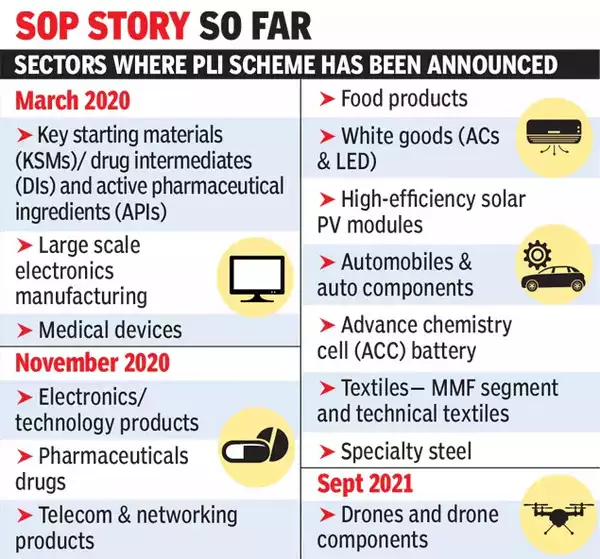Indian Economy
PLI and India’s Growth Ecosystem
- 01 Feb 2023
- 4 min read
For Prelims: Production Linked Incentive scheme (PLI), Manufacturing Sector, Ease of doing business, 5G, Green technologies, Carbon footprint, Free trade agreements, One-district-one-product, SFURTI.
For Mains: Incentives Under the Production Linked Incentive scheme, PLI Contribution to India’s Growth Trajectory.
Why in News?
As the world adjusts to a new economic reality in the wake of the Covid-19 pandemic, India has recognized a strategic opportunity to establish itself as a key player in the global value chains.
- The manufacturing industry’s positive response to the Production Linked Incentive scheme (PLI) is likely to upgrade the labor force’s skills, replace old machinery, enhance production volumes and make logistics and operations efficient, giving India a chance to become a key manufacturing player.
What is the Production Linked Incentive scheme (PLI)?
- About:
- The Indian government's introduction of the PLI scheme in 14 key manufacturing sectors is a significant step towards achieving its strategic vision for the manufacturing industry.
- With a budget of ₹1.97 lakh crore, the scheme is well-designed to encourage growth and sustainability in the targeted industry through various incentives and support measures.
- Launched in March 2020, the scheme initially targeted three industries:
- Mobile and allied Component Manufacturing
- Electrical Component Manufacturing and
- Medical Devices
- The Indian government's introduction of the PLI scheme in 14 key manufacturing sectors is a significant step towards achieving its strategic vision for the manufacturing industry.
- Targeted Sectors:
- The 14 sectors are mobile manufacturing, manufacturing of medical devices, automobiles and auto components, pharmaceuticals, drugs, specialty steel, telecom & networking products, electronic products, white goods (ACs and LEDs), food products, textile products, solar PV modules, advanced chemistry cell (ACC) battery, and drones and drone components.
- Incentives Under the Scheme:
- The incentives given, are calculated on the basis of incremental sales.
- In some sectors such as advanced chemistry cell batteries, textile products and the drone industry, the incentive to be given will be calculated on the basis of sales, performance and local value addition done over the period of five years.
- The emphasis on R&D investment will also help the industry keep up with global trends and remain competitive in the international market.
- The incentives given, are calculated on the basis of incremental sales.
How PLI is Creating a Growth Ecosystem in India?
- Reducing Dependency on Imports: This shift in the manufacturing landscape could have significant implications for global trade, reducing dependency on a single-source country and diversifying the sources of production.
- Meeting the Demand: Increased production volumes are meeting consumer demand, particularly in the telecom and networking sectors with faster adoption of 4G and 5G products.
- The PLI scheme for large-scale electronics manufacturing (LSEM) saw successful results, with 97% of mobile phones sold in India now being made in India. As of September, 2022, the PLI scheme for LSEM attracted investments of ₹4,784 crore and generated 41,000 additional jobs.
- Reducing Carbon Footprint: The PLI scheme's emphasis on green technologies will reduce the carbon footprint and position India as a pioneer in green policy implementation.
- Boosting Free Trade Agreements: Improved productivity is boosting free trade agreements for better market access and increased sales are driving demand for better logistical connectivity.
- Frontlining Rural India: The government of India is working closely with states to help industries and artisans in rural areas become part of the country's growth story.
- This is being done through initiatives such as "one-district-one-product" to support local businesses, and "SFURTI" to improve traditional industries.





